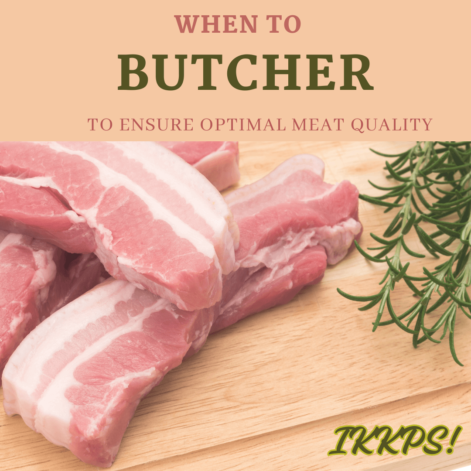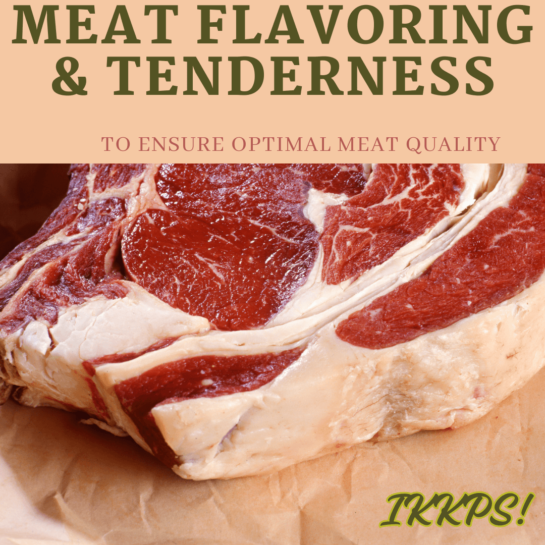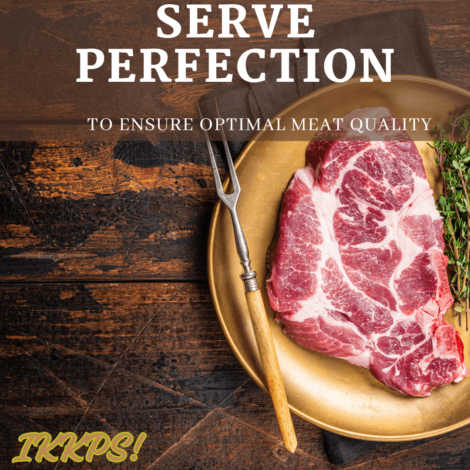
Sign Up
Want to receive a newsletter to learn more about KuneKune pigs and other educational information? Sign up to have them delivered right to your inbox.
We look forwarded to sending you some great info.
When to Butcher KuneKune Pigs
Ensuring Optimal Meat Quality
Are you considering raising Kunekune pigs for meat? Understanding the optimal time to butcher these pigs is vital for ensuring superior meat quality. In this article, we will explore the factors to consider when determining the appropriate time to butcher your Kunekune pigs. The simple answer to when to butcher KuneKune pigs is between 8-15 months of age and between 150-250 pounds. Learn why it is important to know what you want from your KuneKune pork and how that affects when to butcher your KuneKune pig.
Introduction
All right, fellow KuneKune enthusiasts! Gear up because we are diving deep into the delicious world of butchering these curly-haired marvels. Whether you are a seasoned pro or a wide-eyed newbie, slicing through the mysteries of optimal timing is about to become your new favorite pastime.
Remember that tough boar you wrestled last year? The one who scoffed at your measly weight guess and threatened to outmuscle the tractor? Yes, him. Imagine his meat, not as a tangled mess of sinew, but as a symphony of marbled tenderness, bursting with flavor that will make your taste buds sing opera. That is the magic of nailing the butchering window for your Kunekunes.
But before you grab your cleaver and go all Hannibal Lecter on your pig friends, hold your horses! Patience, grasshopper, is the secret sauce. We are talking about coaxing out the best of their meat, not turning them into bacon before their prime.
Crack open the KuneKune Cookbook of Knowledge:
So, let us ditch the dusty manuals and crack open the KuneKune cookbook of knowledge. In this article we will explore the following:
- The Age Game: When are these furry friends ready to graduate from mud baths to meat markets? We will unveil the sweet spot between youthful exuberance and mature flavor.
- Weight Watchers for Pigs: Is a hefty hog the holy grail, or should you aim for a leaner, meaner meat machine? We will break down the weight-to-taste equation and find the perfect balance.
- Marbling Mania: Forget the fake stuff in store-bought meat. We will show you how to cultivate natural marbling in your Kunekunes, turning their flesh into a canvas for juicy, melt-in-your-mouth masterpieces.
- Environmental Enchantment: Hot summers and frosty winters - how do they affect your piggy friends’ meat magic? We will navigate the seasonal dance and find the timing that keeps the quality singing.

Butchering is not just about hacks and cuts; it is about understanding the rhythm of your Kunekunes. It is about respecting their journey and transforming them into culinary treasures that will have your family and friends begging for seconds (and thirds!). So, buckle up, grab your notebooks, and get ready to write your chapter in the KuneKune culinary saga. We are about to turn those oinks into oh-my-God-that's-good!
KuneKune Pork: A few words
Kunekune pigs are known for their high-quality meat that is succulent, tender, and flavorful. However, the timing of butchering plays a significant role in achieving the best results. By waiting until the pigs have reached the ideal weight and age, you can ensure that the meat is of the highest quality, providing a satisfying dining experience for you and your customers.
To determine the precise time for butchering a pig, numerous factors must be considered. These include the pig's weight, age, and overall health. Additionally, it is essential to consider your specific goals, whether you aim to achieve the highest meat yield or the best marbling and tenderness. This information will help you make an informed decision.
To master the art of butchering Kunekune pigs and producing top-notch meat, stay tuned for insightful tips and expert advice in this comprehensive guide. Get ready to savor the best-tasting pork you have ever experienced!
The importance of optimal meat quality
Producing high-quality meat is crucial for any farmer or individual raising Kunekune pigs for meat. The taste and tenderness of the meat depends on the overall eating experience greatly depends on the quality of the meat. When it comes to Kunekune pigs, their naturally slow growth rate and unique genetic characteristics contribute to the exceptional taste and texture of their meat. However, to fully harness the potential of their meat, it is important to understand when to butcher these pigs.
Factors to consider when deciding when to butcher Kunekune pigs.
Age and Weight Considerations
These pigs tend to have a slower growth rate compared to commercial breeds, which means that allowing them to reach the appropriate age and weight is essential for optimal meat quality.
When it comes to determining the appropriate time to butcher your Kunekune pigs, age and weight are two critical factors to consider. While there is no one-size-fits-all answer, generally, Kunekune pigs are ready for butchering between 8 and 15 months of age. By this time, they have had enough time to develop the necessary fat content and marbling, resulting in a more flavorful and tender meat.
At this point, they would have reached the optimal weight range of around 150-250 pounds for a good meat yield. However, it is important to note that individual pigs may vary, so regular monitoring of their growth is necessary. This weight range ensures that the pigs have developed enough muscle and fat, providing a well-balanced meat quality.
Body Condition Scoring
In addition to age and weight, evaluating the body condition of your Kunekune pigs is essential. Body condition scoring involves assessing the pig's overall health, muscle development, and fat deposition. Ideally, the pigs should have a moderate amount of fat cover over their ribs, loin, and rump. This ensures a good balance between meat yield and marbling. Too little fat can result in dry and tough meat, while excessive fat can negatively impact the meat's taste and texture.
Aim for a body condition score of 3 to 4 on a scale of 1 to 5, with 1 being extremely thin and 5 being obese. A pig with a body condition score of 3 to 4 has an ideal balance of muscle and fat, resulting in meat that is not excessively lean or overly fatty.
To determine the body condition score, visually assess the pig's overall appearance and feel its body. Look for signs of well-rounded muscle and a moderate layer of fat. Avoid butchering pigs with a body condition score of 1 or 5, as these extremes can negatively impact meat quality.

Fat Content and Marbling
The fat content and marbling of the meat greatly influence its flavor, tenderness, and juiciness. Kunekune pigs are known for their ability to produce well-marbled meat, which enhances the eating experience.
Marbling refers to the intramuscular fat that is dispersed within the muscle fibers. This fat adds flavor and moisture to the meat, resulting in a more enjoyable dining experience. Butchering the pigs at the right time ensures that the fat content and marbling are at their optimum levels.
Meat Flavor and Tenderness
The flavor and tenderness of the meat are influenced by numerous factors, including the pig's age, diet, and genetics. Older pigs tend to have stronger flavors, while younger ones have milder tastes. The feeding regimen also plays a role, as pigs raised on a diverse diet tend to have more flavorful meat. The tenderness of the meat is influenced by the pig's age, muscle development, and proper handling during the butchering process. By considering these factors, you can ensure that the meat from your Kunekune pigs is flavorful and tender.
Environmental Factors and Seasonal Considerations
Environmental factors, such as temperature and humidity, can affect the growth rate and overall health of your Kunekune pigs. During hot and humid seasons, pigs may experience reduced appetite and slower growth. It is important to consider these factors when determining the optimal time for butchering.
Additionally, seasonal considerations can also play a role in the availability of resources, such as pasture and feed. By aligning the butchering time with favorable environmental conditions, you can ensure that your pigs are in their best condition before processing.
Butchering Techniques for Kunekune Pigs
Once you have determined the optimal time to butcher your Kunekune pigs, it is important to utilize proper butchering techniques to ensure the best meat quality. Here are some tips to consider and we will explore them more in-depth further into this article below.
1. Humane slaughter: Prioritize the humane slaughter of the pigs, ensuring minimal stress and discomfort during the process.
2. Proper equipment: Invest in high-quality butchering tools and equipment to ensure clean and precise cuts.
3. Packaging and storage: Properly package and store the meat to maintain its freshness and quality. Vacuum-sealed bags or butcher paper are commonly used for packaging pork.
4. Meat handling: Handle the meat with care to prevent contamination and maintain its quality. Keep it refrigerated or frozen until further processing.
5. Cut selection: Familiarize yourself with the different cuts of pork and choose the ones that align with your desired end products. Consider the cooking
methods and recipes you plan to use when selecting the cuts.
By following these butchering techniques, you can maximize the quality and value of your Kunekune pig meat, ensuring a satisfying experience for your customers.
Humane Slaughter
Humane slaughter refers to the methods and practices employed to minimize pain, distress, and suffering that animals may experience during the process of ending their lives. It goes beyond ensuring a quick death and encompasses the entire process leading up to slaughter, including the handling, transport, and stunning methods employed. Humane slaughter recognizes that animals deserve to be treated with respect and dignity, leading to a vast improvement in animal
welfare standards.
Animal welfare improvements can positively impact the quality of meat, reducing stress-induced physiological responses, such as the release of stress hormones,
ensuring better taste and quality. The humane slaughter of KuneKune pigs should, therefore, be a non-negotiable imperative for all stakeholders involved in their production and processing.
Proper Equipment
Scalding Tank
The first and most obvious tool needed for pig butchering is a sturdy and well-maintained pig scalder or scalding tank. This is used to scald the pig to loosen the hair and make it easier to remove. The water temperature needs to be carefully controlled to prevent the pig's skin from becoming tough. Scalding also helps remove any impurities or dirt from the pig's skin. For smaller-scale operations, a large pot or barrel can be used as a makeshift scalding tank.
Pig De-Hairing Machine
A pig dehairing machine or scalder dehairer - This machine uses rotating rubber fingers or bristles to remove the hair from the pig's skin. It is essential to choose a dehairing machine that is powerful enough to handle the pig's size and is made from food-grade materials to maintain proper hygiene.
Sharp and Sturdy Butcher's Knife and a Cleaver
The butcher's knife is used to make precise cuts and separate the different cuts of meat, while the cleaver is employed to split the pig into halves or quarters. It is important to maintain the knife's sharpness to ensure clean and effortless cuts. A sharpening stone or butcher's steel should be readily available to keep the blade in optimal condition.
High-Quality Meat Saw
A high-quality meat saw is another indispensable tool in the butchering process. It is used to cut through the pig's bones, making it easier to separate the different cuts of meat. A sturdy saw with a sharp blade will minimize effort and reduce the risk of injuries. Additionally, sawdust or water can be used as a lubricant to ease the cutting process and ensure cleaner cuts.
The point of using dummy text for your paragraph is that it has a more-or-less normal distribution of letters. making it look like readable English.
Once the meat is processed, it must be stored at the appropriate temperature to prevent spoilage and maintain food safety. Refrigeration and cold storage facilities are essential to ensure that the pork remains fresh until it reaches the consumer. These freezers and refrigerators should be routinely monitored to ensure that the temperature is maintained within the appropriate range to prevent the growth of harmful bacteria.
Packaging
Proper packaging plays a vital role in preserving the taste, texture, and nutritional value of Kunekune pork. When done correctly, packaging creates a barrier against air, moisture, and light, thereby minimizing the risk of bacterial growth, spoilage, and freezer burn. Additionally, effective packaging techniques enable convenient storage, easy portioning, and clear labeling, enhancing overall organization during the meat preparation and consumption process.
Vacuum-sealed bags are popular due to their ability to remove excess air and create an airtight environment that prevents deterioration caused by oxygen exposure.
These bags are available in assorted sizes and can suit different cuts and quantities of pork. Alternatively, airtight, freezer-safe plastic containers with secure lids can also be used for packaging smaller cuts or ground Kunekune pork.
Labeling Tip
Accurate labeling and dating of the packaged Kunekune pork are crucial for easy identification and to ensure timely consumption. Each package should be marked with the cut, date of packaging, and weight if known, allowing you to prioritize the usage of meat based on its freshness. This labeling system will help avoid any potential wastage or confusion when selecting cuts from the freezer.
Cut Selections
Pork Loin
One of the most common and versatile cuts from the KuneKune pig is the pork loin. The loin is a lean cut of meat that offers tenderness and a subtle pork flavor. It
is ideal for grilling or oven roasting as it remains tender and juicy throughout the cooking process. The loin can be cut into thick pork chops, which are perfect for marinating and grilling. Alternatively, it can be roasted whole and seasoned with herbs and spices for a more significant gathering or celebration. The pork loin can also be sliced into medallions for stir-frying or thin cutlets for schnitzel, offering endless possibilities for delicious meals.
Pork Belly
Another exceptional cut from the KuneKune pig is the pork belly. Although commonly associated with bacon production, pork belly can be used for various recipes,
especially those requiring slow cooking. Known for its rich and succulent flavor, the pork belly is perfect for braising or roasting. When slow-cooked, it becomes incredibly tender, and the fat renders, resulting in a delectable and buttery texture. This cut is often used in Asian cuisine. It can also be cured and smoked to make homemade bacon, a real treat for breakfast lovers.

KuneKune Pork Shoulder
For those looking for a cut with marbling and intense flavor, the KuneKune pork shoulder is an excellent choice. The shoulder is a tougher cut due to its active muscles, but when cooked low and slow, it becomes incredibly tender and flavorful. This cut is perfect for pulled pork, stews, or braised dishes. It can be slow-cooked in a barbecue or oven, resulting in juicy and melt-in-your-mouth meat. Additionally, the pork shoulder can be sliced into steaks and marinated for grilling, offering a delicious alternative to the more popular beef steak.
KuneKune Pork Hock
KuneKune pork hock is a hidden gem that should not be overlooked. The hock is the lower part of the pig's leg, and although it requires longer cooking times, it
rewards with outstanding flavors and an irresistibly rich gelatinous texture. This cut is perfect for hearty dishes such as rustic stews, soups, or traditional German pork knuckles. The hock can be roasted, braised, or slow-cooked, allowing the collagen to break down and create luscious, fork-tender meat that falls off the bone.
Conclusion for When to Butcher KuneKune Pigs
In conclusion, understanding the optimal time to butcher your Kunekune pigs is crucial for ensuring superior meat quality. By taking into consideration factors such as age, weight, body condition scoring, fat content, marbling, meat flavor, tenderness, environmental factors, and butchering techniques, you can produce top-notch meat that will delight your taste buds.
Raising Kunekune pigs for meat is a rewarding endeavor that requires attention to detail and a commitment to quality. By following the guidelines outlined in this comprehensive guide, you can ensure that your Kunekune pig meat is succulent, tender, and flavorful, providing a dining experience that will leave an impression.
So, get ready to savor the best-tasting pork you have ever experienced by mastering the art of butchering Kunekune pigs and producing meat of the highest
quality. Your efforts will be rewarded with satisfied customers and a reputation for excellence in the meat industry.
Additional Resources on this topic:
Registry Office
17500 Hamilton Arms Court Dewitt, VA 23840